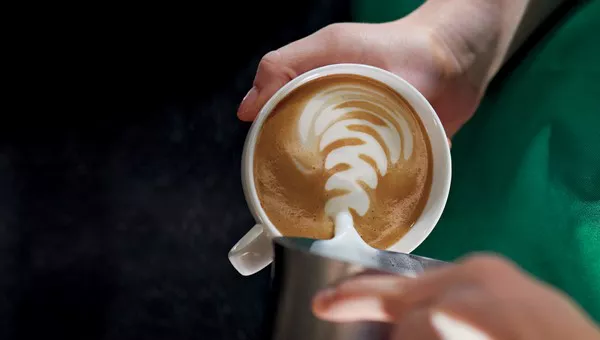Cappuccino, with its velvety foam and rich espresso base, is a beloved coffee beverage enjoyed by enthusiasts worldwide. Crafting the perfect cappuccino begins with selecting the right coffee beans. In this guide, we’ll explore the key factors to consider when choosing coffee beans for cappuccino, including types of beans, roast profile, flavor notes, bean quality, grind size, brewing technique, milk steaming, and recommendations for top coffee beans.
Types of Coffee Beans
When it comes to coffee beans, two primary varieties dominate the market: Arabica and Robusta. Arabica beans are known for their nuanced flavors, acidity, and aromatic qualities, making them a popular choice for specialty coffee drinks like cappuccinos. Robusta beans, on the other hand, are prized for their bold, earthy flavor and higher caffeine content.
For a balanced cappuccino, a blend of both Arabica and Robusta beans can be ideal. Arabica beans contribute complexity and acidity, while Robusta beans add body and crema to the espresso base. This combination creates a well-rounded flavor profile that complements the creamy texture of the milk.
Roast Profile
Traditionally, dark roast coffee beans are preferred for cappuccinos due to their bold flavor and rich aroma. Dark roasting caramelizes the sugars in the beans, resulting in a deep, smoky flavor profile with hints of chocolate and spice. These robust flavors can stand up to the creamy milk foam in a cappuccino, creating a harmonious balance of taste and texture.
Flavor Notes
When selecting coffee beans for cappuccino, it’s essential to consider the flavor notes that will complement the milk. Look for beans with nutty, chocolatey, and earthy undertones, as these flavors pair well with the creamy sweetness of steamed milk. Additionally, beans with hints of caramel or toffee can add a delightful sweetness to the cappuccino without the need for additional sweeteners.
Bean Quality
The quality of the coffee beans is paramount to the overall taste and enjoyment of a cappuccino. Opt for high-quality beans that are freshly roasted and sourced sustainably. Factors like freshness, origin, and roasting technique can significantly impact the flavor and aroma of the final brew. Choose beans from reputable roasters who prioritize quality and ethical sourcing practices.
See Also: What Is Coffee Powder For Baking
Grind Size
For brewing espresso, the grind size of the coffee beans is crucial. A fine grind is recommended for espresso, as it allows for optimal extraction and the formation of a rich, flavorful crema. Investing in a high-quality burr grinder is essential for achieving a consistent grind size that is suitable for espresso brewing.
Brewing Technique
Brewing the perfect espresso is a skill that requires precision and attention to detail. Start by ensuring that you have a good-quality espresso machine with the capability to maintain stable water temperature and pressure. Properly tamp the coffee grounds to create a uniform surface for extraction, and aim for a brewing time of around 25-30 seconds for a well-balanced espresso shot.
Milk Steaming
Steaming milk is an essential step in preparing a cappuccino, as it creates the luxurious foam that distinguishes this drink. To achieve the perfect microfoam, start with cold, fresh milk and submerge the steam wand just below the surface. Position the steam wand at an angle to create a whirlpool effect, heating the milk evenly and incorporating air to create a creamy foam. The ideal temperature for steamed milk is around 150-160°F.
See Also: All You Need To Know About Coffee Blends
Recommendations
Here are some top coffee beans recommended for cappuccinos, along with their pros and cons:
Lavazza Super Crema: A blend of Arabica and Robusta beans with a medium-dark roast profile, offering a creamy texture and rich flavor. Pros: Smooth, velvety crema; balanced flavor profile. Cons: May be too mild for some palates.
Counter Culture Coffee Hologram: A single-origin blend with notes of chocolate and caramel, roasted to perfection for a bold and balanced cappuccino. Pros: Exceptional flavor complexity; sustainably sourced beans. Cons: Higher price point.
Intelligentsia Black Cat Classic Espresso: A classic espresso blend with hints of dark chocolate and molasses, crafted for a smooth and creamy cappuccino experience. Pros: Consistent quality; ideal for espresso-based drinks. Cons: Limited availability outside of specialty coffee shops.
Stumptown Hair Bender: A blend of Latin American and Indonesian beans with a dark roast profile, offering a full-bodied flavor and rich crema. Pros: Bold, chocolatey flavor; versatile for espresso and milk-based drinks. Cons: Some may find it too intense.
Blue Bottle Coffee Giant Steps: A single-origin Ethiopian coffee with floral and citrus notes, roasted to a medium-dark profile for a vibrant and complex cappuccino. Pros: Unique flavor profile; ethically sourced beans. Cons: May not suit traditional cappuccino preferences.
Conclusion
By selecting high-quality beans with the right flavor profile and roast level, mastering the art of cappuccino brewing becomes a rewarding and enjoyable experience. Experiment with different blends and brewing techniques to discover your perfect cup of cappuccino.


